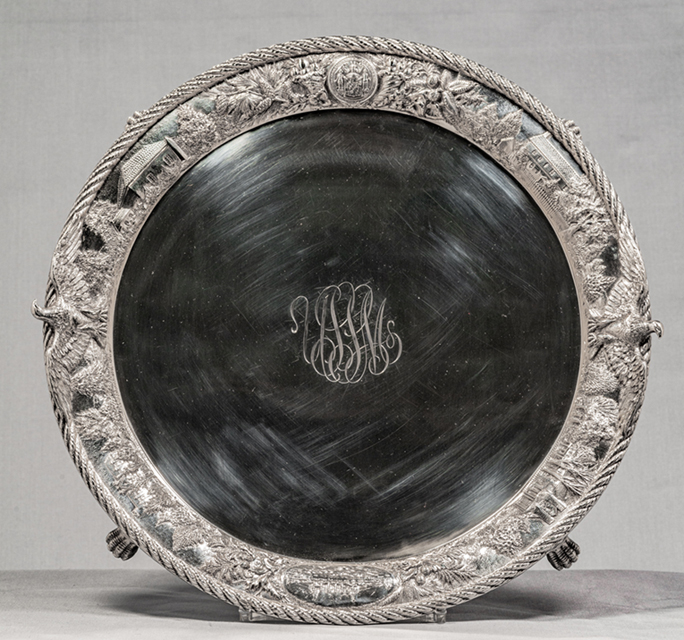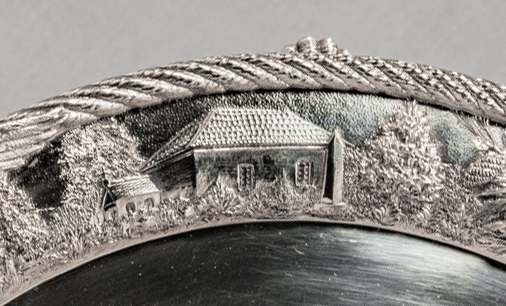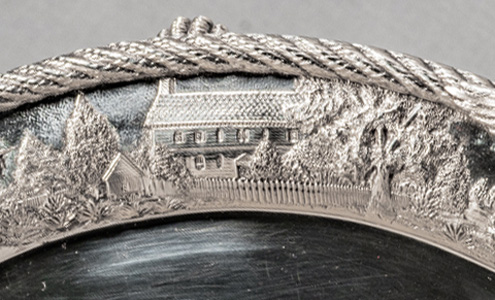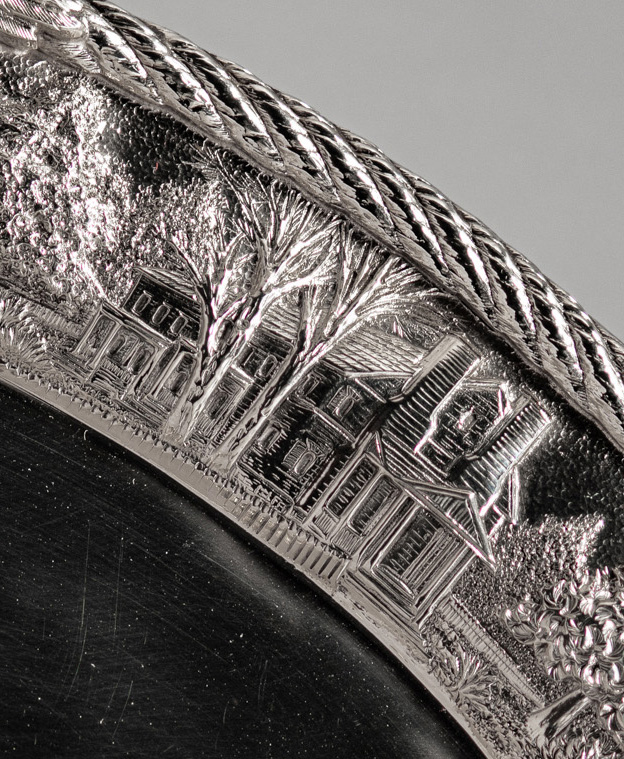Coffee Waiter, Prince George's County
From the USS Maryland Silver Service

Maker: Samuel Kirk & Sons (1815-1979)
Object: Coffee Waiter, Prince George’s County
Date: 1906
Medium: Sterling Silver
Dimensions: Overall length (eagle to eagle) 14"
Accession number: MSA SC 1545-0922
Prince George’s County is represented by this footed coffee waiter, which accommodates the display of the four-piece coffee service. The county was erected from Calvert and Charles counties in 1695. It was named for Prince George of Denmark (1653-1708), the husband of Queen Anne (1665-1714), who ruled Great Britain and Ireland from 1702 to 1714.
The scenes depicted on the coffee waiter represent the early history of Prince George’s County. The Great Seal and the Cruiser are both flanked by sprays of oak, yellow pine, chestnut, tobacco, corn, and other native plants; cornucopias on either side of the seal contain an array of native fruits and vegetables. As with the other servers, the “USSM” monogram is engraved in the center, two eagles are applied to the sides, and the rope border surrounds the perimeter. Curiously, none of the scenes on this particular piece are numbered on the silver itself.
Scenes across the top (left to right):1. St. John’s Church, Broad Creek (number 150)
The original church on this site was called the Church of the Piscataway and was established in 1692, but, in 1726, the name was changed to King George’s Parish. The brick church depicted on the coffee waiter was constructed in 1723 and expanded in 1768. It is believed that President George Washington attended the church during visits to the area. St. John's was added to the National Register of Historic Places in 1974.

3. Harmony Hall on Broad Creek (number 151)
The National Park Service acquired the estate in 1966 in order to preserve southern Maryland cultural heritage.

Scenes across the bottom (right to left)
1. Marlboro House (number 148)
This historic house, located on the main street in Upper Marlboro, was purported to house the state’s early provincial records, as well as those of Anne Arundel County Courts when the Council of Safety ordered their removal from Annapolis. It was built c. 1722, but major improvements were made on the house c.1780.
From 1830 to 1850 the house was owned by the governor of Maryland from 1844-47, Thomas Pratt. The house was later used as an inn, hotel, and antique shop.

2. USS Maryland Cruiser
3. Maryland Agricultural College [University of Maryland] (number 149)
The precursor to the University of Maryland at College Park was the Maryland Agricultural College, which was chartered in 1856. The first classes were held in October 1859. In 1916 the state took control of the college and renamed it the Maryland State College of Agriculture. In 1920, it merged with the University of Maryland in Baltimore to form the University of Maryland.
The original building shown on the coffee waiter was destroyed in 1912 by a fire.![Maryland Agricultural College [University of Maryland]](images/uss_md_149a.jpg)
|
This web site is presented for reference purposes under the doctrine of fair use. When this material is used, in whole or in part, proper citation and credit must be attributed to the Maryland State Archives. PLEASE NOTE: The site may contain material from other sources which may be under copyright. Rights assessment, and full originating source citation, is the responsibility of the user. |
© Copyright August 07, 2024 Maryland State Archives
